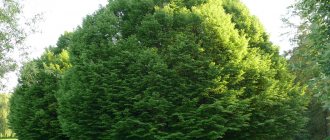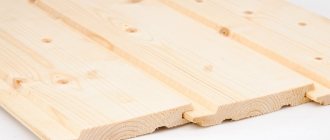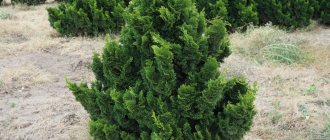Weeping willow is a tall tree 15 m high, with an even trunk and a pyramidal crown. Life expectancy is 100 years.
Author of the article
Maxim Sverchkov
Professional biologist and breeder with extensive experience and experience.
Features of weeping willow
One of the most common types of vegetation in the Northern Hemisphere is the weeping willow, which is a deciduous tree. According to experts, willow is an ancient tree, since some of its species existed on Earth before the Ice Age began.
People call willow broom, willow, willow, willow, etc. Weeping willow, or Babylonian willow, is a representative of woody plants of the Willow family. Its maximum lifespan is no more than 100 years.
Appearance
The external characteristics of willow largely depend on the species. Thus, the weeping willow on average reaches a height of 16 to 20 m. The spectacular crown includes long branches hanging almost to the ground. The surface of the branches is glossy green-yellow or red.
The oblong leaf plates can reach from 10 to 16 centimeters in length, while their width is only about 2 centimeters. Along the entire length of the plate, the color of the foliage is different: at the top it is greenish-gray, at the base it is dark green, and the border is pale gray.
Such a plant has catkins that form after or before the appearance of foliage. The earrings are ovoid in shape, and they grow on small branches. The earrings have an unremarkable greenish-yellow color.
Flowers, fruits and roots
The plant has a well-developed root system, so it is often used to strengthen the soil. However, the wetter the soil on the site, the weaker the development of the root system will be.
Willow produces small capsule-shaped fruits containing seeds inside. They are very small and have pubescence on the surface. The flowers of this plant are yellowish-white in color. Its flowering begins in the last spring or first summer weeks.
Spreading
Experts have found approximately 500 species of willow. Moreover, They are found in different parts of the world. However, most of them are located in the Northern Hemisphere. In nature, weeping willow is found in Siberia, Northern China, as well as in the northern part of Europe and America. This species can also be found in the central part of Russia. Most often, weeping willow is found on the coasts of lakes and rivers.
Types of weeping willow
Like most other plants, the weeping willow has several species. Below we will describe those species that are most common in culture.
Weeping white willow
This powerful tree is resistant to frost. Its height is about 25 m. While the plant is young, it has a narrow crown. However, after some time, its shape changes and becomes spread out. The main stems are directed upward, while the hanging side shoots are directed downward to the surface of the earth. At first, the foliage is painted in an unusual silvery shade, which over time gives way to pale green. This type of willow is light-loving, but it can also grow in the shade.
Yellow weeping willow
This variety is fast growing. However, it prefers to grow in well-lit areas. The foliage is of average size - about 12 centimeters. Winter frosts do not harm the plant; it can withstand temperatures as low as minus 40 degrees. Thin shoots are distinguished by increased flexibility and light color, which is why the name of the tree is associated. Not demanding on the soil.
Dewy willow
This variety has another name - Shelyuga Siberian. The size of an adult plant is average - from 8 to 12 m. This species prefers to grow on river banks. The foliage is green in color, with the inside being slightly yellow. The color of the branches is dark brown, and there may be plaque on their surface.
Yellowbark willow, or golden willow
This powerful tree can reach 20 meters in height. It does not make any special demands on the soil and grows well even in depleted soil. It tolerates both summer heat and winter frosts well.
Willow whole leaf
This is an unusual dwarf decorative species. Its appearance is very attractive, and therefore it is often used to decorate garden plots. This species is low-growing; the height of an adult tree, as a rule, does not exceed three meters. The flowering plant smells very pleasant, and its smell is similar to hyacinth. Flowering begins in the last days of May. Can be used both for solo planting and for group planting.
Willow in the garden. 5 best types of DECORATIVE WILLOW: Goat, Hakuro - Nishiki, Nana, Twisty, Weeping willow.
Other names
Most people call the common tree “willow,” and few people know that it has other names. And certainly no one will name all 8 nicknames of willow:
- Rakita.
- Vine.
- Vetla.
- Lozina.
- Willow.
- Shelyuga.
- Beloloz.
- Willow.
This is in addition to the Latin name of the tree - Salix, which translated from Celtic means “close to water”.
Planting a Weeping Willow
Choosing a landing site
When choosing the most suitable location for planting weeping willows, special attention should be paid to the characteristics of the soil. It was already mentioned above that such a tree can be grown in any land. However, if you want it to grow and develop within normal limits, then it is better to choose sandy or loamy soil for planting it. At the same time, its humidity can be any, but willow feels best in moist soil.
In nature, willow propagation occurs by seed. In this case, gardeners propagate the tree by cuttings or seedlings. As a rule, gardeners do not have any difficulties purchasing and planting seedlings in open ground. After all, what could be easier than purchasing a ready-made tree and planting it in suitable soil.
Willow planting
Reproduction and planting of weeping willow
It is recommended to harvest cuttings of weeping willow in winter. The best option for the cutting is the middle part of the shoot, which should not be older than two years.
In order for the cutting to take root successfully, you need to follow the following rules:
- The length of the segment should reach approximately 30 centimeters (no more);
- Planting for rooting is carried out in a greenhouse, greenhouse or heated room.
- In order for the cutting to take root and grow faster, it is provided with regular, frequent watering and loosening of the substrate. If desired, the seedling can be fed with solutions of agents that stimulate root growth.
- The piece should take root fairly quickly, after which it will begin to grow. However, at this time it is not planted in open ground. The seedling must spend one winter in a warm place. Then a year later it is planted in open ground.
Reproduction of weeping willow
Optimal timing of fir cuttings
Preparation of cuttings begins in early spring or already in autumn. You can also carry out the procedure at the beginning or end of summer. The most optimal time for preparing planting material is spring, when active sap flow has not yet begun. For the southern regions this is March; for colder climates you should wait until April. Cuttings are cut in the morning or on a cloudy but not rainy day. You should not do this in direct sunlight. When preparing planting material in the spring, the shoots will take root this year.
It is permissible to carry out cuttings in June, when the plant is developing intensively. But in this case, a full-fledged root system will develop only next year. In the current season, only callus is formed.
Important! Callus is connective tissue that grows around a wound to protect it from external influences. If time is lost at the beginning of summer, then cuttings can be prepared in August
During this period, they slow down their growth, and lignification begins. Winter cuttings are prepared until November
If time is lost at the beginning of summer, then cuttings can be prepared in August. During this period, they slow down their growth, and lignification begins. Winter cuttings are prepared until November.
When harvesting shoots in summer and spring, they are rooted immediately, and when collected in the fall, they are stored in a cool, ventilated area until the next season. The temperature for cuttings should be maintained at up to + 5 °C. Such conditions can be created by placing planting material in containers and putting them in the refrigerator. Next season it will be possible to grow fir from cuttings.
Weeping willow care
Watering
Throughout the summer, as well as on hot days, the plant needs to be watered abundantly. In dwarf varieties, on hot days it is recommended to moisten the crown itself by sprinkling. During the summer months, the tree is watered every day. And in winter it can be watered once every 7 days.
Fertilizer
Willow needs feeding immediately after planting in a permanent place and for the first time. However, fertilizing is not at all necessary. If the soil contains the optimal amount of nutrients, then the tree does not need to be fed at all.
Trimming
Not every willow can be pruned, as it can stretch up several meters (the average is 15 to 20 meters). If pruning is still possible, and it is necessary, then it is recommended to carry it out in the spring. Proper pruning has a positive effect not only on the appearance, but also on the health of the plant.
What are the baskets made of?
Due to the fact that willow shoots are long and bend well, they are widely used in wicker weaving . Interestingly, the vine is used not only for weaving baskets. Boxes, dishes, sculptures, toys and even furniture are also made from willow. It is used to make hedges, including living ones. The material is not only convenient for manufacturing, but also very affordable.
Diseases and pests
Weeping willow, which grows in open ground, is susceptible to disease and pests. However, any preventive measures cannot give a 100% guarantee. In this regard, you should study in advance the problems that a gardener may encounter in the process of growing such a tree, and also understand how to deal with them.
The greatest danger is posed by diseases such as:
- black or brown spotting of leaves;
- powdery mildew;
- white heart-shaped rot (destroys the trunk from the inside);
- crown gall;
- willow scab, etc.
In order to prevent the emergence of a variety of diseases and pests, one should not forget about basic preventive measures. To do this, a thorough inspection of the willow is carried out regularly. Remove dried and fallen leaves in a timely manner, treat the tree trunk and moisten the soil only when it is really necessary.
You can prevent pests from appearing on the plant through regular preventive treatment with special products that can be purchased at a specialty store.
Meaning and Application
Weeping willow has a very impressive appearance, and it is also a useful plant. Beneficial features:
- The tree is often used as a living fence. At the same time, it provides a dense, cool and fairly large shadow.
- The plant is able to take root even in depleted soil, and it contributes to its improvement. As a result, favorable conditions are created for growing crops that are more demanding on soil quality.
- The twigs of such a plant are called vines. They are used for weaving furniture.
- Willow wood is quite popular in carpentry.
Weeping willow in landscape design
If there is an artificial pond or small river on your site, then its main decoration can be a luxurious weeping willow. This plant looks most impressive near bodies of water, which is why landscape designers often use it in their work.
Dwarf and decorative varieties of such a crop can decorate not only a garden plot, but also a house.
The mighty and beautiful weeping willow is suitable for creating any design. It not only has a spectacular and rather unusual appearance, but also helps create comfortable conditions for the growth and development of other cultures.
Willow - species and varietal diversity
Medicinal properties
Within the bark and milky sap of the willow tree, there is a substance called salicylic acid.
Decoctions are an effective remedy for the treatment of: sore throat, oral disease, pain, varicose veins. muscle fatigue.
People from different times and cultures have discovered and used the effective properties of the substance to treat headaches and fever.
- Fever and pain relief. Hippocrates, a physician who lived in ancient Greece in the fifth century BC, discovered that willow bark, when chewed, could reduce fevers and reduce pain
- Dental care - Americans discovered the healing properties of willow bark and used it to treat fevers, arthritis, headaches and toothaches. In some tribes, the willow was known as the "toothache tree".
- Inspired by synthetic aspirin, British minister Edward Stone experimented in 1763 on willow bark and leaves and identified and isolated salicylic acid. The acid caused too much stomach upset to be widely used until 1897, when a chemist named Felix Hoffman created a synthetic version that was good for the stomach. Hoffman called his invention "aspirin" and produced it for his company.











